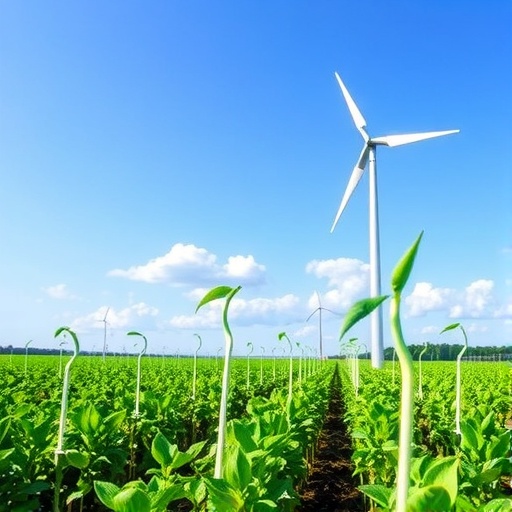
In the face of mounting global challenges related to food security and environmental sustainability, China stands at a crucial crossroads. As the world’s most populous nation, China feeds nearly one-fifth of humanity while cultivating less than one-tenth of the globe’s arable land. This remarkable feat, however, has historically been achieved through a model of agriculture characterized by extraordinarily high inputs of chemical fertilizers. China accounts for approximately 32% of global nitrogen fertilizer consumption, a figure surpassing that of any other country by a significant margin. While such intensive practices have contributed to impressive crop yields, they have also inflicted considerable stress on ecosystems, including widespread soil acidification, contamination of water bodies by nitrates, and elevated particulate matter emissions, notably PM2.5—a critical public health concern.
Confronting these environmental externalities without compromising food production is a pivotal challenge confronting agricultural scientists and policymakers alike. It is within this context that a team led by Professor Wenfeng Cong at China Agricultural University has pioneered a transformative approach termed “green technology.” This methodology has been rigorously validated over thousands of field trials nationwide, a scale and breadth rarely matched in agricultural science. Their approach not only illuminates pathways toward reconciling high-yield agriculture with ecological stewardship but also reframes the agricultural research paradigm itself by advancing a novel conceptual framework dubbed the “12345” model.
The “12345” model reimagines agricultural innovation as fundamentally anchored in real-world production demands. It emphasizes solving the inherent contradictions prevalent in modern farming—between maximizing grain yield and ensuring environmental protection, and between fostering economic development alongside ecological preservation. This paradigm mandates cross-disciplinary collaboration and active involvement from multiple stakeholders, from farmers to scientists, enabling tailored, practical solutions that synthesize agronomic, environmental, and socioeconomic factors.
.adsslot_kNXOCet9gb{width:728px !important;height:90px !important;}
@media(max-width:1199px){ .adsslot_kNXOCet9gb{width:468px !important;height:60px !important;}
}
@media(max-width:767px){ .adsslot_kNXOCet9gb{width:320px !important;height:50px !important;}
}
ADVERTISEMENT
At its core, the green technology approach optimizes the intricate “soil-crop-microbe” system to harness synergies that drive enhanced productivity, nutrient efficiency, and minimized pollution. The strategy is tripartite. Firstly, it involves constructing high-density crop populations through breeding dense-tolerant varieties and manipulating planting densities or deploying intercropping systems. Intercropping, such as the cultivation of corn alongside fava beans, effectively maximizes light interception and heat utilization, boosting photosynthetic efficiency and resource capture.
Secondly, green technology prioritizes precise rhizosphere regulation to fine-tune nutrient uptake dynamically. This is accomplished via “smart” fertilizers that synchronize nutrient release with crop developmental stages and leverage ammonium nitrogen forms to stimulate root architectural changes favorable for phosphorus acquisition. Such precision fertilization enhances nutrient use efficiency, directly contributing to lower fertilizer requirements without sacrificing yield.
Thirdly, the approach fosters the cultivation of healthy soils through integrated management practices. These include the combined application of organic amendments alongside chemical fertilizers and the adoption of conservation tillage or no-till systems. The dual focus is on improving soil structure and bolstering microbial diversity—a foundational factor in sustaining nutrient cycling and soil resilience.
The empirical validation of these principles is grounded in an unprecedented dataset from 12,403 field trials spanning fifteen years (2005–2020) driven by a nationwide collaborative framework. The outcomes are robust and compelling. Relative to conventional management, green technology elevates grain production by a remarkable 21% to 87%, achieved without corresponding increases in nitrogen fertilizer inputs. More impressively, Nitrogen Use Efficiency (NUE) improves by 24% to 32%, signaling marked reductions in nutrient wastage. Concurrently, nitrogen losses and greenhouse gas emission intensities decline by 50% to 56% and 31% to 47%, respectively, underscoring significant environmental benefits.
By 2015, this innovative technology had been embraced by roughly 20.9 million farming households across 452 counties in China, covering an agricultural expanse of 40 million hectares. Such large-scale adoption not only marks a turning point for Chinese agriculture but also presents a scalable model of sustainable intensification that other nations could emulate. Amid global uncertainties in fossil fuel markets, rising fertilizer costs, and escalating climate change impacts, strategies that prioritize “less input, more output, and low pollution” are more crucial than ever.
China’s experience underscores the feasibility of this triple-win paradigm. Should green technology be widely implemented, it holds the potential to dramatically mitigate the environmental footprint of Chinese agriculture—substantially lowering global resource consumption, nutrient runoff, and greenhouse gas emissions linked with crop production. The approach aligns synergistically with multiple United Nations Sustainable Development Goals, including hunger eradication, clean water, climate action, and sustainable land use.
More than a technical intervention, the green technology framework embodies a shift toward holistic, systems-based thinking in agronomy. It moves beyond isolated innovations, promoting integrated management that leverages advancements in plant breeding, nutrient management, soil science, and microbial ecology. Such interdisciplinarity, coupled with concerted stakeholder participation, exemplifies how science can meaningfully address the complex socio-ecological challenges facing modern agriculture.
For farmers on the ground, green technology translates into tangible benefits: increased yields, higher profitability through better input efficiency, and improved environmental conditions that sustain productivity long term. For policymakers and researchers worldwide, it provides a valuable blueprint for balancing productivity with sustainability in diverse agro-ecological contexts.
In summary, the green technology initiative led by China Agricultural University is not only a breakthrough in agricultural science but a beacon for global food systems transformation. It showcases how combining scientific rigor, innovation, and inclusive collaboration can design agricultural models that meet today’s pressing needs without compromising the planet’s future. As the global community grapples with the intertwined crises of food insecurity and environmental degradation, the lessons from China’s green technology and the “12345” model offer both hope and a practical roadmap toward resilient, sustainable agriculture.
Subject of Research: Not applicable
Article Title: Green technology for increasing grain crop production and efficiency: innovation and application in China
News Publication Date: 16-Jul-2025
Web References: http://dx.doi.org/10.15302/J-FASE-2025630
Image Credits: Wen-Feng CONG, Hao YING, Feiyu YING, Zhichao AN, Jianbo SHEN, Fusuo ZHANG
Keywords: Agriculture
Tags: agricultural science advancementsChina’s agricultural challengesecological impact of farmingenvironmental sustainability in farminggreen technology in agriculturehigh-yield farming techniquesinnovative agricultural methodsnitrogen fertilizer consumption reductionpublic health and agriculturereconciling food security and environmental protectionsoil health and ecosystem preservationsustainable food production practices





